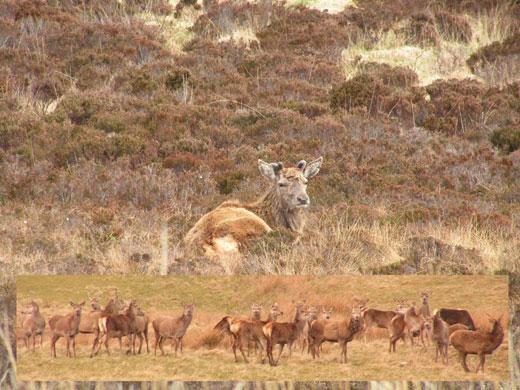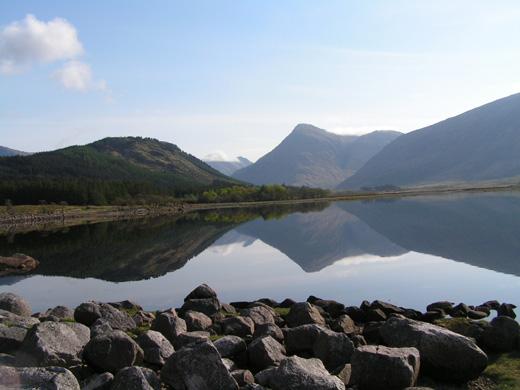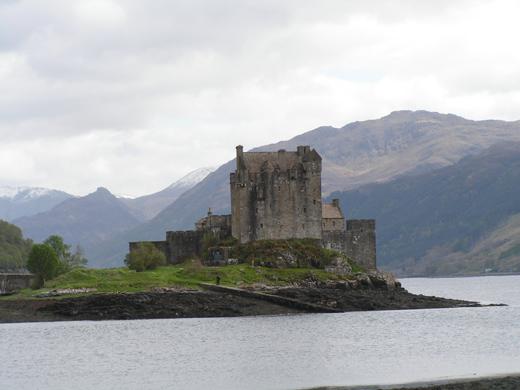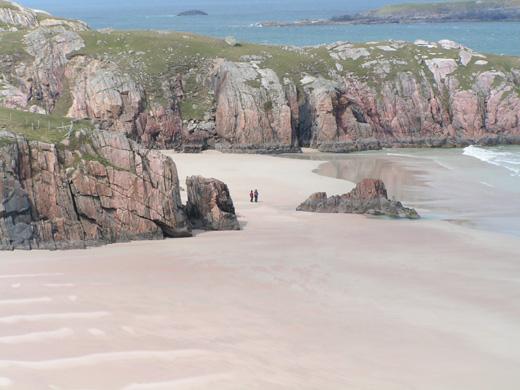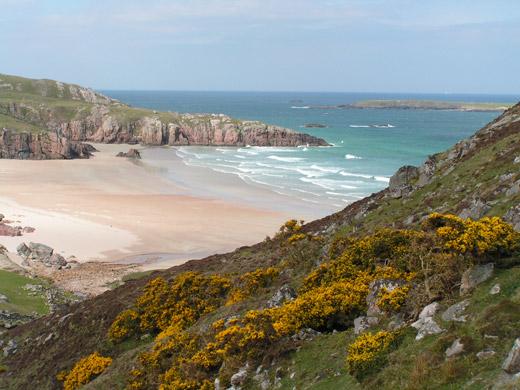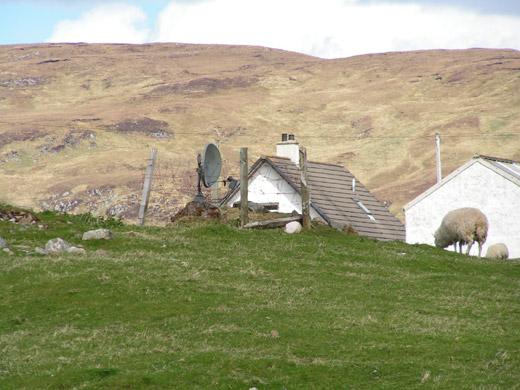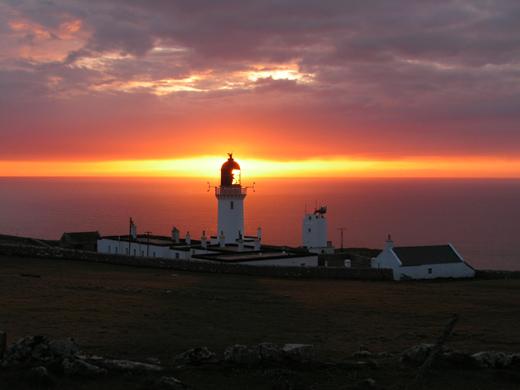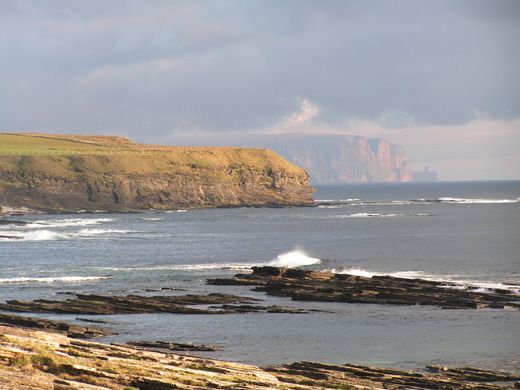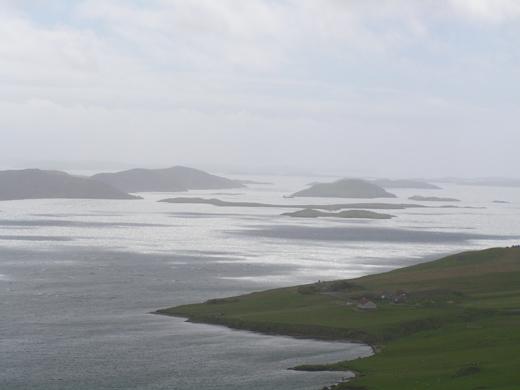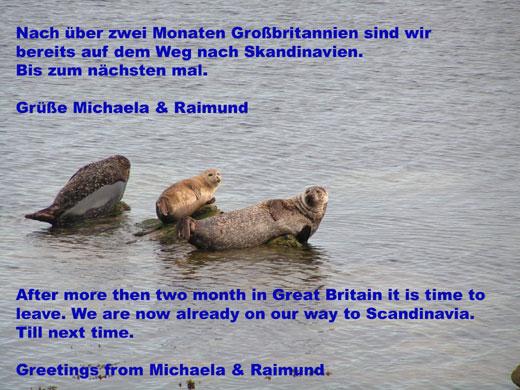This country is to beautiful that we don´t want to bother ourselves to work here and in the moment we still have time and a bit of money to do without.
see picture in German Version … as well the East coast of Scotland has it´s appeal
After one week at the East coast we are longing for the peace and tranquillity as well the beauty of the Northwest coast of Scotland.
A lot of animals which are already extinct in Germany we can watch here from a very short distance. For example deer. On our last holidays here in Scotland we came back from a trekking tour and saw right in front of our car a herd from about 50 of them. Since they were separated from us through a fence, we thought: ok that’s a deer breed. But a few days ago we chatted with a forester and he explaint to us that the fence is there to protect the villages from the deer. They would otherwise eat all the new planted trees. So you can see lots of Deer grit instead of cattle grids (which we already explained in our last travel journal. If we count just the deer, which we have seen the last 6 weeks we definitely come more then over a thousand without exaggeration.!! ( I know I personally do sometimes exaggerations, but God thanks Raimund is the opposite). So therefore, you can trust me. The forester told further on that the deer in this area can be a real nuisance. Unfortunately you can’t do so much against it, since the Highlands are a wetland and therefore they are out of sight quiet quick. We certainly being only “watchers” appreciate it a lot to watch them in big herds.
Then there is here the world of birds. Species which you can´t look at them anymore or died out, like the Tetrao urogallus (latin, I could not find the English word for it), the cuckoo, the peewit, the Somateria mollissima (latin, same thing) and so on. Here we can see them in droves. Every time we pitch camp for the night, a cuckoo is greeting us.
Raimund assert that this cuckoo is always the same and he travel’s with us already through whole Great Britain (?). In a way we became already a kind of birdwatcher, even if we have instead of this huge monsters (they look like canons) just a tiny binocular. But it does it´s job.
When we are telling about our past travels to Scotland, people are always asking us: „And how do you cope with the food“ Honestly to say, we don´t. As we all know, food in Great Britain is a lot of fast-food and deep-fried. Even the best scampi’s are coming deep-fried! But if somebody like we, would like to see the world with not much money, then there is anyway no question about going into a restaurant or even into a pub. (In the pubs you get so called Pub food which is the smaller version of a restaurant food but never the less the price for German standards are quiet high: 7,50 Euro for a kind of starter and up to 25 Euro for the main course). Some of the Scottish dishes we still would like to mention. Haggis which is minced innards of a sheep mixed with oats, the Scottish National dish. It tastes much better as it sounds, to be honest we love it! As well the dishes made from deer are fantastic. Very tender, nicely spiced and not even deep-fried!! After a Scottish dinner it is certainly a must to have a glass of one of their hundreds of good Single Malt Whisky’s
But through the years we already noticed quiet a change in the cuisine as well in the food stores. A few years ago you could not buy any other bread then this wobbly white and brown toast (sorry our dear English friends, but we do love our good black bread from Germany). But know you can already buy so called French sticks which is really tasting like French baguettes. Well and yesterday by coincidence we saw a counter where you could taste “German bread” and it was not just looking like German bread, it tasted nearly like our bread at home. But unfortunately they had no stock of this bread, it was just that people could taste it. Strange sales strategy.
Now to our further on route. Like we mentioned already, we did drive again back to the North-West, where there is not just the beautiful mountain range, as well you can find here on a sunny day, beaches like in the South Pacific or in the Caribbean Sea. Just the temperature is a bit lower.
On such places we certainly stay for a longer period.
Then the street leads us passed deserted villages and farmhouses.
So more we come to the East again, the countryside is much more densely populated.
Once in Thurso, the first bigger town since a week, we have to fill up our grocery stock. Since one or two years Germany has landed in Great Britain: A Lidl Supermarket. We do not want to make any advertisement but compare to the other supermarket chains we can save lot´s of money going shopping at Lidl. For example vegetables and fruits are half the prize if you buy them on a Friday or Saturday. But even the rest of the food, drinks and even toiletries is much cheaper. A lot of the stuff is coming all the way from Germany. For example the Mozzarella cheese. In another supermarket chain the price for mozzarella is about 1,30 Scottish Pounds, at Lidl you get it for 0,69 Scottish Pound. As we had a closer look onto the back of the package we were quiet astonished. It was produced in Cham in Upper palatinate/ Bavaria.
This are now our last days on the mainland in Scotland. At the lighthouse at Dunnethead, where we have already been 3 weeks ago, we pitch our camp.
The last time we where here, we saw the Orkney Islands just from a distance. Now, better to say at the next day, we take the ferry to the Orkney Islands. The sea swings the old ferryboat in about 1 ½ hours into the save harbour of St. Margaret´s Harbour. After just half an hour on the islands we realize that we are now in a complete new surrounding. Nothing like the Scottish Highlands, just wide green farmland with lots of cattle and sheep. From nearly every point of the island you have eye contact to the sea. In the west of Orkney it is a bit more hilly and there are even cliffs.
The Orkney Islands and especially the bay of Scapa Flow are a paradise for wreck divers. In both world wars the islands have been the scene for war historical events with German participation. The high sea fleet of the German empire, at that time the second biggest after the British one, have been intern in November 1918 in the home harbour of the British navy Scapa Flow. The ships have been disarmed and been controlled by the British. Just an emergency crew of sailors were on all of the 70 German ships. On the 21st of June 1919 after the British navy set out for a manoeuvre in the North sea, the commanding officer of the intern unit, Konteradmiral Ludwig von Reuter, gave the command to sink there own ships. He presumed that the German Government would not accept the peace treaty and the hostility would continue next day. As the British navy returned from the manoeuvre the bay of Scapa flow was a “sea of rubble”. In the 2nd World war, lieutenant-commander Günter Priem did the impossible. He managed to come in one of the two access into Scapa Flow with the submarine U-47 unnoticed and sank the warship HMS Royal Oak with 1400 crew on it. At the Cathedral of Kirkwall we found a commemorative plaque which commemorates 880 sailors, which have been drowned. Most of the wrecks of the sunken ships have been elevated, but still there are a few on the bottom of the sea. Divers from all over the world love this diving ground
We go further to the North, to the Shetland Islands (60. latitude) This islands are half way between Scotland and Norway and exists of about hundred islands with 22 000 inhabitants and 330 000 sheep.
This time it is a night trip. At 11.15 pm we enter the ferry. After we have set up our night camp, we go once more outside to the rail to get some fresh sea air. It is already 0.10 am and still not dark, infect it is still twilight. The duration from the Orkney to the Shetland Islands lasts 7 ¾ hours. The rhythmical noise of the ship puts us to sleep on the relatively comfortable sleep chairs, which are looking kind of cinema chairs. Shortly before 7.00 am a voice from the loudspeaker wakes us up. “In half an hour we will arrive Lerwick“ After checkout we drive to a nearby hill, have breakfast and get the first impressions about Lerwick and the Shetland Islands.
For the next days we prepare our travel route.
Today we drive to the most westerly points of Shetland Mainland, where we pitch a camp right next to the Lighthouse. We have a terrific view over the sea. The wind gets stronger. After a careful consideration we decide to try to find a bit more secured spot for the night. During the night it starts to rain. I am half asleep as I hear Michaela: “Oh my God… we are standing with our bus right in the middle of a creek”. There, were six hours ago still was dry ground, is now a small river. But fortunately the ground is quiet hard, so we have no problems to bring our bus back onto the road. The wind and the rain are becoming quiet strong. You even can see the rain walls which the wind carries around. We stay in the bus and read and look at movies which we can watch on our laptop and which we brought with us along for this “extreme sunny days”
During the next days it gets colder. Temperature is around 4 ° – 7° C. The stationary heating is mostly on duty. In the evening we hear on the world radio the temperatures in Germany “ Hamburg 31° C, Frankfurt 30 ° C und Munich 28 ° C “. In that moment we think we must be nuts. The weather unfortunately is not changing to better for the next two days. Therefore we decide in the morning to go back to Lerwick. There is an indoor swimming pool where we relax in the whirlpool and our mind is in Germany with sunny temperatures.

